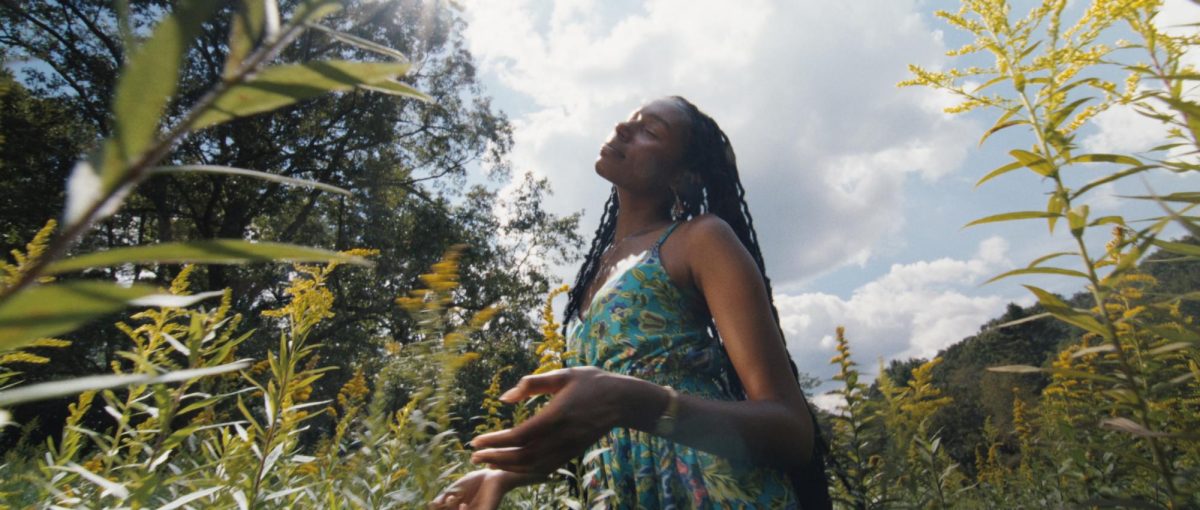
By Kirby Caraballo
Jesse Goldman, a UNC Asheville graduating senior political science student, found a passion for mindfulness and decided to share that passion with his peers. He started a mindfulness club in the Spring 2013 semester — only his second semester of college.
“My first experience with meditation was back in high school in Westchester, New York. There was this Buddhist monastery called Chuang Yen and they’d offer Sunday meditations,” Goldman said. “I went to like five or 10 of those. I had an interest in it, but I wasn’t that involved.”
But as Goldman describes his freshman seminar class with Rick Chess, a professor in the literature and language department at UNCA, his eyes light up and his eyebrows raise in excitement.
“One day in class we just started doing mindfulness. Then, after my second semester, I submitted paperwork to start a mindfulness club.”
That was the beginning — the start of all his accomplishments and the beginning of a practice that helps shape his identity every single day.
He starts with a routine. Every morning, he rolls his pillow up the same way. He faces the same direction. He assumes the same position. And he sits, perfectly still, for what seems like forever.
When you look at him, he appears lost in his own head. His eyes are closed beneath his bushy, unkempt brows. His face stays relaxed and his scratchy untrimmed beard remains perfectly still. He looks peacefully asleep, drifting along an uncharted plane — but in reality, he keeps constantly and extremely aware, acutely focused on his thoughts, his breathing and his surroundings.
“I don’t know why I was so attracted to it in the beginning,” Goldman said. “I guess I was just surrounded by this kind of cool and mysterious energy, like I was trying to figure something out.”
When Goldman meditates, his breath becomes audible. It sounds steady and loud, like the swishing of a rain stick, or the rhythmic crashing of ocean waves on a sunny, sandy shore.
He holds an intention, a sort of integrity, which he said remains very important to mindfulness. He quotes Jon Kabat-Zinn who, like Goldman, pioneered a mindfulness movement program at the University of Massachusetts.
“‘Mindfulness means paying attention in a particular way; on purpose, in the present moment and nonjudgmentally,”Goldman said, quoting him perfectly, using his hands to roll out the words.
Goldman said he finds comfort in the routine, the self-discipline. “I like doing something every day, no matter what. If it wasn’t mindfulness, it might be reading or running. I like to have daily practices. It just helps keep me on track.”
Considering his untamed appearance, he keeps pretty organized. Goldman’s accomplishments since starting college have added up. After starting the mindfulness club three years ago — which he said just keeps growing each year — he began to work with a local middle school.
What started out as a small week of community service for a service-learning course, quickly turned into a grant project. The administrators of Asheville Middle School said they were impressed, so Goldman received permission to set up a long-term teaching program with the kids. This semester will be his fourth 12-week-long session in two years.
“We teach them balance — physically, mentally and emotionally.”
During a session with the middle schoolers, Goldman pulls out heaps of what look like really long seatbelts and he sets these belts up in long lines of varying heights and tensions. By the end of it, the room looks like an enemy laser room from the James Bond movies.
A palpable tension lies in the room as these kids shuffle in their seats, excited and nervous for something they looked forward to for who knows how long.
What he wants them to do is called slacklining, balancing on strip of webbing suspended above the ground.
They start out with a little mind and body awareness, gradually preparing for when they dare to approach the wobbling ropes. The 22-year-old student explains that slacklining requires focus ; the students must remain aware of what the body does, as well as its reactions.
“Basically by walking on this line, we are teaching them mindfulness through that,” he said.
Goldman also works with a variety of campus events, including the upcoming Mindfulness Festival in April, a mostly student-run event, and the Creating a Mindful Campus conference May 23-24, a primarily faculty-oriented event aimed at promoting resilience and contemplative teaching and learning among higher education, according to UNCA officials.
Ameena Batada, a UNCA assistant professor in the health and wellness department and a member of the planning committee for the Creating a Mindful Campus event, used to teach Goldman’s service-learning course.
“I have been involved with a learning circle for faculty on campus that focuses on contemplative pedagogy, and we have planned this event for the past four years,” Batada said.
According to Batata, contemplative pedagogy focuses on helping students to actually spend some time thinking about or focusing on different topics, issues and experiences.
Batada said the event will start with a faculty workshop this year on contemplative practices in the classroom. After that will be an evening speech by Tish Jennings, an associate professor at the Curry School of Education at the University of Virginia, which will focus mainly on mindfulness and resilience in higher education.
“I began practicing mindfulness before I became a teacher, and when I started teaching, I began to notice that my own teaching practice was better. I was able to handle the stress of students and didn’t take things so personally,” Jennings, author of the book Mindfulness for Teachers, said.
She will be offering insight on how to be mindful and aware of certain stressors in the classroom, and how to be resilient in dealing with those stressors in her talk during the conference, Jennings said.
“Mindfulness for me was really the key for me in learning how to cope with these emotionally provocative situations in the classroom that happen all the time,” Jennings said.
According to Goldman, the interdisciplinary and secular nature of mindfulness makes it wide-reaching.
“There is this fear of increasing secularization,” he comically purses his lips and mocks in a faux-serious tone, “that we will just make it about ‘focus and concentration training’ and kind of take away the meaning of that.”
But he adamantly states that isn’t entirely true. He scoots up in his seat and leans forward, as if he wants to drill this idea into his listeners’ brains. It becomes apparent he has riled himself up.
“What I’m interested in right now on a personal level is really, I wanna call it post-secular.”
He explains it, leaning even closer, like he’s sharing a juicy secret, like he has the whole world figured out — with this the key.
“Now we’re at a point where we’re seeing more acceptance of different people and different religions. To me, post-secular could mean you walk into a room with a different group of people and fully own up to your personal, religious and spiritual beliefs. And so could everyone else.”
According to him, that compassion and empathy has a lot to do with mindfulness. He calms down now, back to his soothing state of being, and he describes in more detail the personal importance of that little Buddhist monastery up in Westchester.
“When I went to that monastery, I wasn’t a Buddhist. Those people who taught me were practicing Buddhists, yet they offered me that experience. They said ‘Please come; you don’t have to convert; we’re here to share this experience with you that is meaningful to us.’”
Goldman said that connection he made, that compassion he experienced, will shape his life every single morning. Every morning when he gets up he sits on the same floor, on the same rolled up pillow, facing the same direction. With his right leg crossed over his left, he closes his eyes, and he meditates.
Goldman sits, far right in white, surrounded by meditating mindfulness club members.
04/05/2016



















